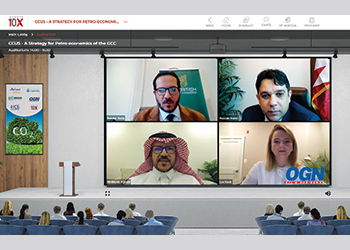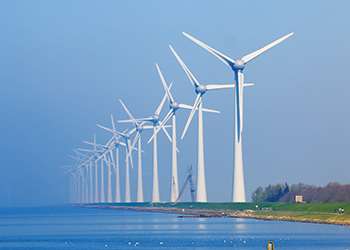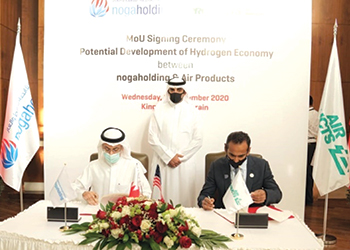
 Power from wind is set to jump by 30 per cent
Power from wind is set to jump by 30 per cent
A rising global population and growing energy demand are challenges facing plans to cut carbon emissions, and if the world wants to achieve net-zero goals as outlined in the Paris Agreement, it has to step up its efforts substantially
The race to achieve the global emissions reduction target as outlined in the Paris Agreement is very challenging, and a clichéd ‘time is running out’ isn’t going to cut it. Unless the global community commits to tangible efforts, the race is far from won.
The ongoing global pandemic has seriously impacted energy usage, which declined around 5 per cent, and correspondingly global emissions dropped by around 7 per cent, the biggest in history. But that is not necessarily good news.
Dr Fatih Birol, Executive Director of the International Energy Agency (IEA), said the decline in emissions is not happening because of the right energy policies or new technologies. "This is happening because of the economic meltdown around the world. Low economic growth is not a low emission strategy" and if governments do not take the right measures to push emissions down, as the global economy recovers, emissions will return to previous levels," he said.
Reaching net-zero emissions in 2050 would require a much more rapid deployment of low-carbon power generation. To ensure a climate-safe future, annual investment in renewables, including various types of power generation, solar heat and biofuels, will have to almost triple to $800 billion by 2050, International Renewable Energy Agency (Irena) said in its ‘Global Landscape of Renewable Energy Finance’ report.
"Many governments have ambitious plans for reducing emissions from the energy sector. Some governments have even put net-zero ambitions into law or proposed legislation, while others are discussing their own net-zero strategies. Many companies have also announced carbon-neutral targets," the IEA said in its Energy Technology Perspectives 2020 report.
In July, the Oil and Gas Climate Initiative (OGCI), a global industry-led organisation energy companies, announced a target to reduce the collective average carbon intensity of member companies’ aggregated upstream oil and gas operations to between 20 kg and 21 kg CO2e/boe by 2025, from a collective baseline of 23 kg CO2e/boe in 2017.
 |
Heavy investment is needed to fight climate change |
The initiative’s members include BP, Chevron, CNPC, Eni, Equinor, ExxonMobil, Occidental, Petrobras, Repsol, Saudi Aramco, Shell, and Total, who altogether account for over 30 per cent of global oil and gas production.
In sharp contrast to all other fuels, renewables used for generating electricity is set to grow. Electricity generated by renewable technologies will increase by 7 per cent globally in 2020, underpinned by the record new capacity additions, the report estimates. This growth comes despite a 5 per cent annual drop in global energy demand, the largest since the Second World War. Within 10 years, the economies of Central and South Eastern Europe could cover 34 per cent of their rising energy demand cost-effectively with renewables.
New additions of renewable power capacity worldwide will increase to a record level of almost 200 gigawatts (GW) this year, contrasting with the sharp declines triggered by the pandemic in other parts of the energy sector, the IEA said in its Renewables 2020 report. This rise, representing almost 90 per cent of the total expansion in overall power capacity globally, is led by wind, hydropower and solar PV.
Wind and solar additions are set to jump by 30 per cent in both the US and China as developers rush to take advantage of expiring incentives.
Global investment in renewable energy made significant progress between 2013 and 2018, with a cumulative $1.8 trillion invested. With the onset of the Covid-19 pandemic, renewable energy investments dropped by 34 per cent in H1 of 2020, compared to the same period the year before.
An even stronger growth is to come, with India and the European Union driving a record expansion of global renewable capacity additions of nearly 10 per cent in 2021, the report Irena.
"Renewable power is defying the difficulties caused by the pandemic, showing robust growth while other fuels struggle," said Birol. "The resilience and positive prospects of the sector are clearly reflected by continued strong appetite from investors – and the future looks even brighter with new capacity additions on course to set fresh records this year and next."
Over the first 10 months of 2020, China, India and the European Union have driven auctioned renewable power capacity worldwide 15 per cent higher than in the same period last year – a new record that shows expectations of strong demand for renewables over the medium and long term. At the same time, shares of publicly listed renewable equipment manufacturers and project developers have been outperforming most major stock market indices and the overall energy sector. By October, shares of solar companies worldwide had more than doubled in value from December 2019.
Critical factors influencing the pace of deployment will be policy decisions in key markets like China and effective support for rooftop solar PV, which has been impacted by the crisis as households and businesses reprioritised investments. Under favourable policy conditions, solar PV annual additions could reach a record level of 150 GW by 2022 – an increase of almost 40 per cent in just three years.
However, renewables outside the electricity sector are suffering from the impacts of the Covid crisis. Biofuels used in transport are set to experience their first annual decline in two decades, driven by the wider plunge in transport fuel demand this year as well as lower fossil fuel prices reducing the economic attractiveness of biofuels. Demand for bioenergy in industry is also falling as a result of the wider drop in economic activity. The net result of these declines and the growth of renewable power is an expected overall increase of 1 per cent in global renewable energy demand in 2020.
"In 2025, renewables are set to become the largest source of electricity generation worldwide, ending coal’s five decades as the top power provider," said Dr Birol. "By that time, renewables are expected to supply one-third of the world’s electricity – and their total capacity will be twice the size of the entire power capacity of China today."
In addition to affordable power, renewable energy will also bring socio-economic benefits by creating numerous jobs worldwide, according to Irena’s figures, which showed jobs in the sector to have reached 11.5 million globally last year. Solar PV created the most number of jobs, at 3.8 million, followed closely by biofuels with 2.5 million jobs created, and hydropower and wind industries, with close to 2 million and 1.2 million jobs, respectively.
Renewables jobs have shown more inclusion and a better gender balance than fossil fuels. The report highlights that women held 32 per cent of total renewables jobs, as opposed to 21 per cent in fossil fuels sectors.
Irena forecast an additional 5.5 million more jobs over the next three years if supported an ambitious stimulus programme.
RENEWABLES IN THE GCC
Although renewable energy continues to attract a growing share of investment in new electricity generation capacity — $370 billion is forecast worldwide in 2020 — very little of this investment is currently slated for GCC states. The GCC is falling behind developed countries such as Germany, and developing economies such as Chile, Mexico, Morocco, and South Africa, according to a report by Strategy & Middle East, part of the PwC network.
The GCC region has considerable renewable energy potential, particularly for solar photovoltaic (PV) generation, the Irena report said.
The region has several factors that make rapid deployment of renewables an attractive opportunity. These include plentiful, high-yield renewable resources; natural gas shortage; and an established independent power plant (IPP) model, which makes cheap, long-term project finance available and can attract the necessary private and foreign investors.
Overall, however, renewable energy has made striking gains in the GCC countries over the past five years. From niche technologies with little application beyond small-scale pilot projects, the project pipeline has grown to almost 7 gigawatts (GW) of new power generation capacity. Record-breaking bids in renewable energy auctions in the UAE and Saudi Arabia in 2016-2018 have, in fact, made solar power cost-competitive with conventional energy technologies, the Irena said.
The UAE hosts close to 79 per cent of the installed solar PV capacity in the GCC and has managed to attract some low-cost solar PV projects without offering subsidies.
With a 57 GW capacity addition, the region is estimated to witness an 18-fold growth of the current capacity, thereby receiving an investment of $182.3 billion by 2025, according to Frost & Sullivan’s recent analysis, Solar PV Dominating Investment Opportunities in Renewable Sector across the Middle East, 2020-2025.
Key drivers of market growth are climate change commitments, abundance of resources, falling costs of renewables, and progressive policies being implemented by countries in the region to promote clean energy and reduce carbon footprint.
A number of renewable energy projects have either been completed in the region, under construction or are in the pipeline.
Set to be the largest solar power plant in the world, the Al Dhafra solar project in Abu Dhabi, UAE, once operational will generate 2GW of electricity, equivalent to powering 160,000 households and removing 470,000 cars.
Last month, His Highness Sheikh Mohammed bin Rashid Al Maktoum, Vice President and Prime Minister of the UAE and Ruler of Dubai, inaugurated the 800-MW Phase 3 of the Mohammed bin Rashid Al Maktoum (MBR) Solar Park, the largest single-site solar park in the world. The park will have a planned capacity of 5,000 MW by 2030 and will provide power for over 240,000 residences in Dubai.
Separately, the 950-MW Phase 4 of the Mohammed bin Rashid Al Maktoum Solar Park is also on track and will be operational in stages starting Q3 2021. It will have the largest energy storage capacity in the world, of 15 hours, allowing for energy availability around the clock, and providing clean energy for 320,000 residences, while helping cut 1.6 million tonnes of carbon emissions a year.
The Mohammed bin Rashid Al Maktoum Solar Park is the largest single-site solar park in the world. With a planned total capacity of 5,000 MW by 2030, it features an investment of AED50 billion.
The total capacity of operational projects at the facility, which uses photovoltaic solar panels, is 1,013 MW. Dewa is creating an additional capacity of 1,850 MW using solar panels and CSP.
Saudi Arabia has moved a step closer to becoming a pace-setter in green energy and sustainability, with the delivery of the first consignment of turbines for the 400-MW Dumat Al-Jandal wind-power plant, an Arab News report said.
The plant is being manufactured by Danish company Vestas. Commercial operations are due to start in Q1 2022. When operational, Dumat Al-Jandal will displace 885,000 tons of CO2 each year, while proving power to 70,000 homes.
Meanwhile, in Qatar, France’s Total and Japan’s Marubeni are set to develop the country’s first large-scale solar IPP plant, with 800 MW capacity. The $500-million Al Kharsaah facility will start operations in 2021 and reach peak capacity in 2022.
In June this year, the 100-MW Amin plant, Oman’s first utility-scale solar project began commercial operations. The $94-million project will produce enough energy to power 15,000 homes.
Also in Oman, a group of international companies have expressed their interest to invest in clean hydrogen projects in the special economic zones and free zones in Oman. The Public Authority for Special Economic Zones and Free Zones is currently evaluating a number of investment requests in this field. It said it has initially designated a dedicated zone coving 100 sq m for clean energy in Sezad.
Following suit, Bahrain too has signed a memorandum of understanding with Air Products to assess the feasibility of developing a hydrogen economy in the kingdom.
The country’s Oil Minister, Shaikh Mohamed Khalifa Al Khalifa, said the joint effort explores the viability of developing hydrogen as a sustainable fuel in the transport sector as well as an avenue to the transition of a lower carbon energy mix in Bahrain.
CONCLUSION
The GCC governments must act urgently to lead the inevitable transition to a modern, renewables-based energy system. Today’s fiscal challenges in particular leave little room for continued indecisiveness and postponed reforms. In this uncertain economic environment, GCC countries will not have the luxury of reversing poor infrastructure investment decisions. They, therefore, need to assess carefully the long-term implications of the path they choose before embarking on it. Excessive focus on the short term could lead to poor decisions, which will have ramifications for decades to come, according to a report by Strategy & Middle East, part of the PwC network.
Other developing countries have already successfully applied a suite of policies and initiatives that GCC policymakers can exploit. International experience points to six critical actions that can be adapted to the specific circumstances of each GCC country. These include setting ambitious, realistic targets grounded in a comprehensive and integrated national energy plan; clarifying the national energy governance framework and define institutional roles and accountabilities; reforming fossil fuel and energy subsidies and reallocate financial resources; broadening the range of financing instruments available; unifying regional standards; and building policymaking and regulatory capabilities.








































































